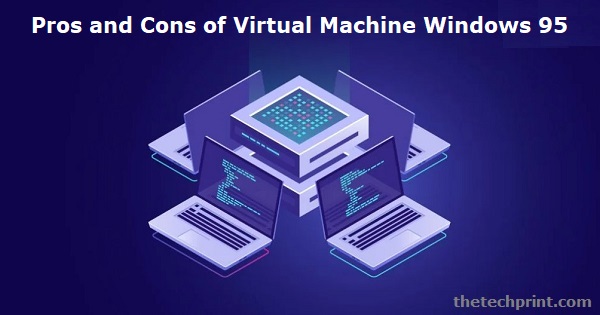Before you get in to the pros and cons of Virtual Machines in Windows 95, you should first know why the OS needs to be on a VM. Microsoft ended its support for Windows 95 in 2001, but you can still run the aging operating system on your PC using a virtual machine. A Windows 95 VM can be useful for running old software or programs that aren't compatible with newer versions of Windows.
There are several different ways to set up a Windows 95 virtual machine. One option is using a Microsoft Azure service to create and manage your VM. Another option is to use a tool like VMware Workstation Player or VirtualBox to create a local VM on your computer.
Windows 95 was a major release of Microsoft's flagship operating system and marked a significant turning point in the company's history. The release of Windows 95 was preceded by a long period of development, beta testing, and hype. It was released on August 24, 1995, and was an immediate success, with over one million copies sold in the first four days.
The user interface was significantly redesigned with the introduction of the Start menu, taskbar, and windows title bar. The new design made it much easier for casual users to use, which helped boost its popularity. It still had a lot to offer for power users and developers, with improved support for networking and multimedia.
Under the hood, Windows 95 was based on the same codebase as Windows NT 4.0 and shared many of its features. This made it much more stable and reliable than previous versions of Windows and helped it to gain a reputation as a solid business platform.
Despite its success, Windows 95 was not without its problems. It was notoriously buggy and was often derided for being slow and resource-hungry. It was also the target of several high-profile viruses, which took advantage of its vulnerabilities to wreak havoc on users' computers.
There are certain pros of Virtual Machine for Windows 95, which are as follows:
If you are very nostalgic about the old times and want to experience the Windows 95 operating system again, this is the best way to do it. You can run all your old favorite programs on this virtual machine without any issues.
It is also a great way to test old software or games that are incompatible with modern versions of Windows. By running them on a virtual machine, you can ensure they will work properly before using them on your main computer.
If you're a developer or power user, you can also take advantage of Windows 95's improved networking and multimedia support. This can be useful for testing purposes or compatibility with older hardware.
There are certain cons of Windows 95 Virtual Machine, which are as follows:
As mentioned previously, Windows 95 was notoriously buggy and unstable. This can be a major problem when running it on a virtual machine, as any crashes or errors could potentially damage your main computer.
It is also quite resource-intensive and will require a fairly powerful computer to run smoothly. If you're not sure whether your machine can handle it, you should check the minimum system requirements before attempting to install it.
Finally, because it is so old, many modern programs and games will not work properly in Windows 95. This can be a major inconvenience, especially if you're trying to run something that is not compatible with the operating system.
Conclusion on Pros and Cons of Virtual Machine for Windows 95
If you’re interested in trying out Windows 95 for yourself, it’s now possible to run a virtual machine on your current computer. While this can provide some fun nostalgia, there are also potential downsides. Running an older operating system on a virtual machine may not be completely stable, and you could experience crashes or data loss.
In addition, any programs or files you access on the virtual machine will be isolated from your main computer, so you won’t be able to transfer data between the two easily. Before setting it all up, weigh the pros and cons of virtual machine for Windows 95 to decide if it’s right for you.

In addition to the many government computers still utilizing Windows 95, at least seven instances of it ran on outside Internet-connected computers in 2017.
Windows 95 cannot start up if there is more than 480MB of memory. (This was considered an incredibly large amount of memory at the time. Remember, Windows 95's target machine was a 4MB386SX, and a powerful machine had 16MB.)
Windows 95 is equipped to run 32-bit programs, which support pre-emptive multitasking and multithreading. This allows users to perform several actions simultaneously. Additionally, 32-bit programs run in their memory space, decreasing the likelihood of a General Protection Fault (GPF).
Since Windows 2000, it's been possible to run out-of-date software in Windows compatibility mode, and it's still a feature that Windows users may utilize to play older Windows 95 games on modern PCs.
Some of the advantages of running a Windows 95 virtual machine include the following:
1. The ability to run older software that is not compatible with newer versions of Windows
2. The ability to run multiple operating systems simultaneously
3. Improved security, as the virtual machine can be isolated from the rest of the system
Some of the disadvantages of running a Windows 95 virtual machine include the following:
1. The need for additional hardware, such as a separate computer or a virtual machine application
2. The need for a copy of the Windows 95 operating system
3. The potential for decreased performance, as the virtual machine will share resources with the host system.